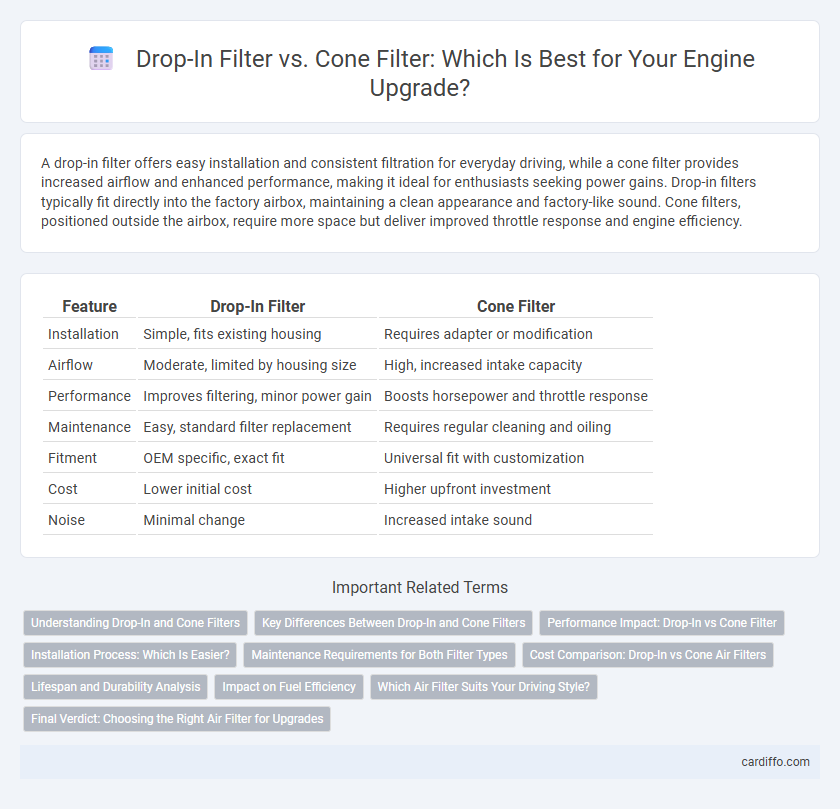A drop-in filter offers easy installation and consistent filtration for everyday driving, while a cone filter provides increased airflow and enhanced performance, making it ideal for enthusiasts seeking power gains. Drop-in filters typically fit directly into the factory airbox, maintaining a clean appearance and factory-like sound. Cone filters, positioned outside the airbox, require more space but deliver improved throttle response and engine efficiency.
Table of Comparison
| Feature | Drop-In Filter | Cone Filter |
|---|---|---|
| Installation | Simple, fits existing housing | Requires adapter or modification |
| Airflow | Moderate, limited by housing size | High, increased intake capacity |
| Performance | Improves filtering, minor power gain | Boosts horsepower and throttle response |
| Maintenance | Easy, standard filter replacement | Requires regular cleaning and oiling |
| Fitment | OEM specific, exact fit | Universal fit with customization |
| Cost | Lower initial cost | Higher upfront investment |
| Noise | Minimal change | Increased intake sound |
Understanding Drop-In and Cone Filters
Drop-in filters are designed to fit directly into the factory airbox, providing a simple replacement that maintains the original housing's airflow dynamics while improving filtration efficiency. Cone filters, with their exposed shape and larger surface area, offer enhanced airflow and performance gains by allowing more air intake but require custom fitting and can introduce more noise. Understanding the specific application and desired balance between ease of installation, filtration quality, and airflow enhancement is crucial when choosing between drop-in and cone filters for vehicle upgrades.
Key Differences Between Drop-In and Cone Filters
Drop-in filters offer a straightforward replacement design that fits directly into the existing airbox, ensuring factory-like seal and easy installation, whereas cone filters provide a larger surface area and improved airflow by extending outside the airbox. Drop-in filters typically maintain stock air intake noise levels, while cone filters often produce a more aggressive intake sound due to increased airflow and less restrictive materials. Maintenance differs as drop-in filters can be swapped quickly without modifying intake components, but cone filters may require periodic cleaning and adjustment for optimal performance.
Performance Impact: Drop-In vs Cone Filter
Drop-in filters provide a modest increase in engine performance by improving airflow compared to standard paper filters, but they are limited by their replaceable design and surface area. Cone filters offer a significant boost in horsepower and torque due to their larger surface area and less restrictive design, promoting better airflow and enhanced engine breathing. For optimal performance upgrades, cone filters deliver superior gains in acceleration and overall engine efficiency compared to drop-in filters.
Installation Process: Which Is Easier?
Drop-in filters offer a straightforward installation process, requiring minimal tools and time, making them ideal for quick upgrades. Cone filters often involve removing the existing housing and may need additional clamps or adapters, which can complicate installation for beginners. For ease of installation, drop-in filters provide a more user-friendly experience, especially for those seeking a hassle-free upgrade.
Maintenance Requirements for Both Filter Types
Drop-in filters require less frequent cleaning but often necessitate complete replacement after prolonged use, making maintenance straightforward yet potentially costly. Cone filters demand regular cleaning to maintain optimal airflow and engine performance, with cleaning intervals depending on driving conditions and filter material. Both filter types benefit from routine inspections to prevent dirt accumulation and ensure efficient filtration, but cone filters generally offer longer lifespan with proper upkeep.
Cost Comparison: Drop-In vs Cone Air Filters
Drop-in air filters typically cost less upfront, ranging from $10 to $30, making them a budget-friendly option for routine replacement. Cone air filters, often priced between $30 and $80, provide enhanced airflow and performance but require a higher initial investment. Over time, cone filters can offer better fuel efficiency and engine protection, potentially offsetting their higher cost with improved longevity and reduced maintenance needs.
Lifespan and Durability Analysis
Drop-in filters typically offer a moderate lifespan ranging from 5,000 to 7,500 miles due to their paper or foam media, which wears faster under harsh conditions. Cone filters, constructed with high-quality oiled cotton or synthetic materials, generally provide enhanced durability and can last up to 25,000 miles with proper maintenance. The robust build of cone filters ensures superior resistance to dirt accumulation and moisture, resulting in improved longevity compared to conventional drop-in filters.
Impact on Fuel Efficiency
Drop-in filters typically offer minimal improvement in fuel efficiency due to their standard design and filtration capabilities. Cone filters, with their larger surface area and enhanced airflow, can increase combustion efficiency, potentially improving fuel economy by up to 3-5%. The choice between drop-in and cone filters directly impacts engine performance and fuel consumption rates.
Which Air Filter Suits Your Driving Style?
A drop-in filter offers a direct replacement with factory-like fit and filtration efficiency, ideal for daily drivers who prioritize maintenance ease and engine protection. Cone filters provide increased airflow and performance gains by reducing intake restriction, making them suitable for enthusiasts seeking enhanced horsepower and throttle response. Selecting the right air filter depends on balancing your driving habits with desired performance outcomes and maintenance preferences.
Final Verdict: Choosing the Right Air Filter for Upgrades
Drop-in filters offer easy installation and are ideal for stock or mild performance upgrades, providing reliable filtration without altering airflow dynamics significantly. Cone filters enhance airflow and engine efficiency in high-performance setups but require proper maintenance and fitment to avoid potential issues. Selecting between drop-in and cone filters depends on the vehicle's upgrade level and the balance between convenience and maximum performance gains.
Drop-In Filter vs Cone Filter Infographic

 cardiffo.com
cardiffo.com